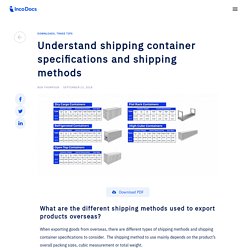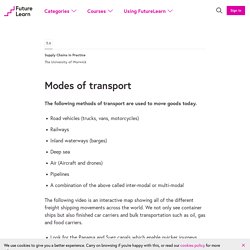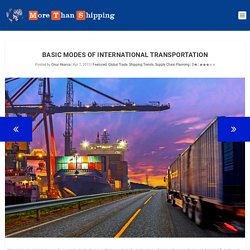

Modes of Transportation: What method is best for cargo and freight? The mode of transportation is an important consideration when planning the shipment process.

Besides the costs, the urgency of the shipment, the value of the goods being shipped as well as the size and weight of the goods need to be evaluated when determining the form of transportation. In this article, we want to help you determine, which mode is best to transport your cargo and freight! Use our free tool to get a freight estimate right away: Calculate your freight rate Ocean Seaborne trade accounts for about 90% of the global trade, and as per UNCTAD, 1687 million tons (2015 estimate) were carried in around 177.6 million containers (2015 estimate) covering 998 billion ton-miles (2016 estimate).
Because of size or volume, there are several types of cargoes that cannot be or is economically unviable to move by other modes of transport than the sea. Ocean freight is a less expensive method of shipping goods, but the drawback is a longer transit time. Understand shipping container specifications and shipping methods Trade Tips. What are the different shipping methods used to export products overseas?

When exporting goods from overseas, there are different types of shipping methods and shipping container specifications to consider. The shipping method to use mainly depends on the product’s overall packing sizes, cubic measurement or total weight. Shipping containers are the most efficient means of transport across the globe. Their design allows multi-modal transport seamlessly between trucks, trailers, port handling equipment, shipping vessels and railheads. Moodle. The following methods of transport are used to move goods today.

Road vehicles (trucks, vans, motorcycles) Railways Inland waterways (barges) Deep sea Air (Aircraft and drones) Pipelines A combination of the above called inter-modal or multi-modal The following video is an interactive map showing all of the different freight shipping movements across the world. We not only see container ships but also finished car carriers and bulk transportation such as oil, gas and food carriers. Look for the Panama and Suez canals which enable quicker journeys throughout out the world. Ship Movements Across the Globe Although a cleaner form of transport, in comparison to air, sea freight does emit carbon as shown on the interactive map. The picture below shows how you can combine the different modes of transport to move products from the factory to their end destination.
Each mode of transport has its advantages and disadvantages. Adapted from Gourdin K, Global Logistics Management 2006 Talking point. Basic Modes of International Transportation - More Than Shipping. International transportation can be a complex mode of serious shipping or it can be a simple way of moving the cargo from point A to point B.

In the end, transportation is to bring your product from one end to the other in the most cost efficient way and in a timely manner. Most companies prefer to deal with logistic companies who can offer combinations of shipping methods. As an importer, depending on your industry needs, you may require different methods of cargo transportation. ITF Transport Outlook. How to move goods by road. This page explains the procedures you must comply with for carrying dangerous goods by road.

You may see two different terms used to refer to these rules - ADR and the Carriage Regulations - but both refer to the same provisions. ADR is a Europe-wide code on dangerous goods, while the Carriage Regulations translate that code into UK legislation. The Carriage Regulations also apply to the transport of goods by rail . The regulations apply to carriers and traders. Traders are often asked to produce the dangerous goods declaration and supporting documents (such as vehicle documentation, safety and accident reporting) and to ensure the goods are suitably packaged and labelled. Classification Any dangerous goods you're transporting must be marked with their name, description and United Nations (UN) number. UN classification groups for dangerous goods. Transportation Modes, Modal Competition and Modal Shift. Author: Dr.

Jean-Paul Rodrigue Transport modes are the means by which passengers and freight achieve mobility. Données essentielles sur l'activité des transports. Données essentielles sur l'activité dés transports Économie et statistique poursuit la publication de ses « données essentielles sur... » établies par la division « Étude des entreprises ».

Après les chiffres les plus significatifs sur l'industrie (n° 14) et le commerce de détail (n° 23), voici un mémento sur l'activité des transports. En 1969, la branche transport occupe 3,5 % de la population active et réalise 4,1 % de la production intérieure brute et 7,8 % des investissements (F.B.C.F. productive). Au cours de la dernière décennie, cette branche a beaucoup évolué. Des entreprises nationalisées coexistent avec des milliers de petites entreprises. Les transports aériens et maritimes sont plus concentrés. Souvent mêlée à d'autres activités, l'activité des transports est difficile à circonscrire : il convient d'abord de distinguer le transport pour compte propre du transport pour compte d'âutrui et d'isoler les nombreuses activités auxiliaires du transport. Section 1 : Les différents modes de transport de marchandises. L'Antenne - Les transports et la logistique au quotidien.
Freight Transportation Options.